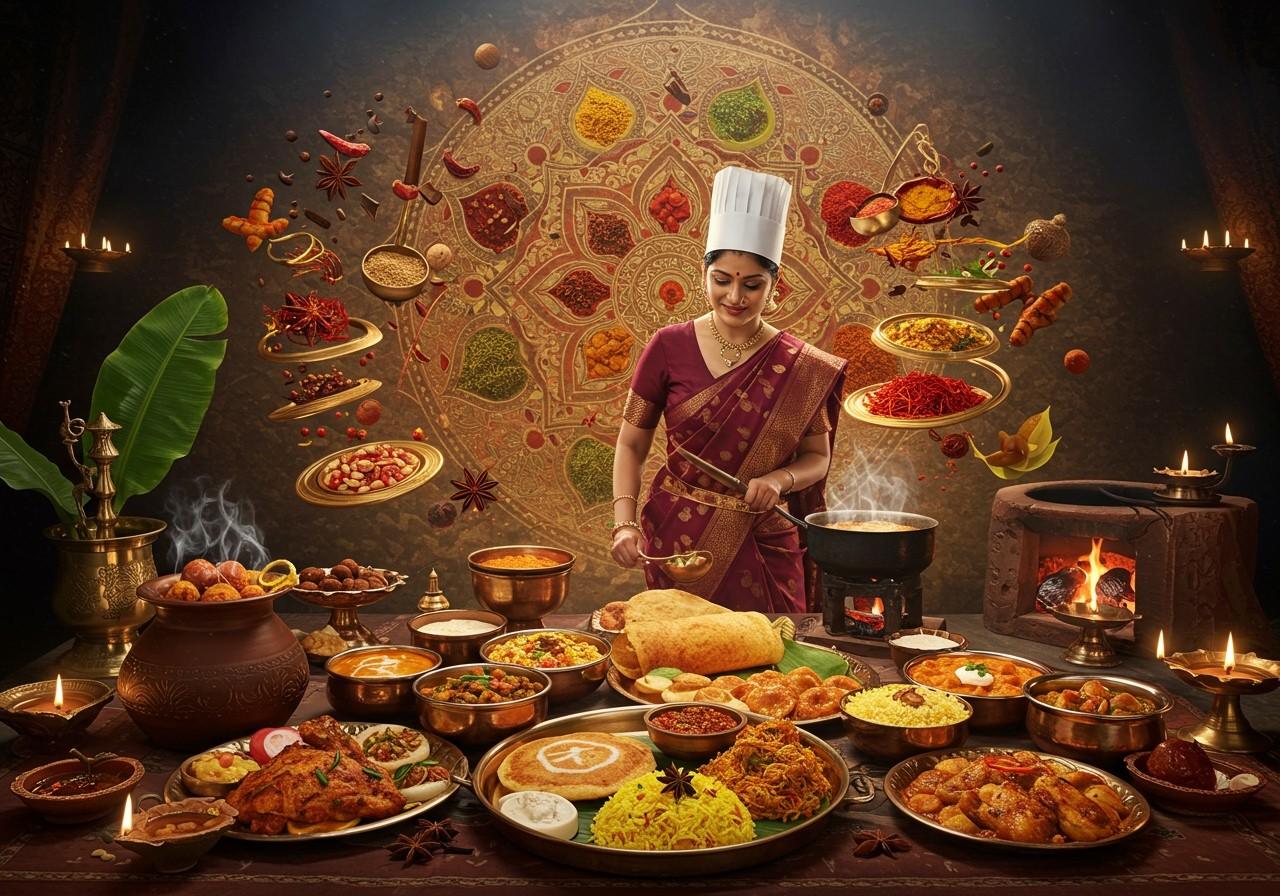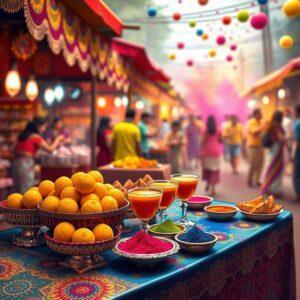
Indian cuisine, a vibrant tapestry of flavors, techniques, and traditions woven over millennia, invites exploration. This blog delves into the intricacies of Indian cooking, from its historical evolution to the diverse regional specialties, essential ingredients, and techniques. We’ll also explore educational avenues and immersive experiences for those seeking to master this rich culinary art. This exploration caters to culturally rooted, middle to upper-middle-class Indians aged 25-60 who appreciate tradition and seek to deepen their understanding of authentic Indian food.
Historical Evolution of Indian Cuisine
Indian cuisine boasts a captivating history, shaped by various influences over centuries. The Mughal era enriched Indian gastronomy with elaborate dishes like biryani and kebabs. The Spice Route, a historical network of trade routes, introduced a medley of flavors and ingredients from across the globe. Each region of India developed its own unique culinary identity, influenced by local resources, climate, and cultural practices. Festivals and religious observances play a significant role in shaping traditional recipes, adding a spiritual dimension to the culinary landscape. Ayurveda, the ancient Indian system of medicine, also holds a prominent place in Indian cooking, emphasizing the balance of flavors and the use of ingredients for their health benefits. Over time, foreign ingredients and techniques have been seamlessly integrated into Indian cuisine, further enhancing its richness and diversity.
Regional Diversity in Indian Cuisine
India’s vast geographical expanse and cultural diversity are mirrored in its regional cuisines. Each region boasts distinct culinary traditions, offering a unique gastronomic experience:
- North Indian Cuisine: Known for its rich use of dairy products, tandoori cooking, and flavorful curries. Popular dishes include butter chicken, naan, and various lentil preparations. The tandoor, a cylindrical clay oven, imparts a smoky flavor to meats and breads, creating signature dishes like tandoori chicken and roti.
- Gujarati Cuisine: Predominantly vegetarian, featuring a delicate balance of sweet, sour, and spicy flavors. Dhokla, a steamed savory cake, and thepla, a mildly sweet flatbread, are iconic Gujarati dishes. The cuisine also emphasizes the use of lentils, vegetables, and yogurt.
- Rajasthani Cuisine: Characterized by its robust flavors and use of spices. Dal baati churma, a hearty dish made of lentil dumplings, is a Rajasthani specialty. The cuisine reflects the region’s arid climate, utilizing preserved ingredients and incorporating unique spices.
- South Indian Cuisine: Known for its spicy curries, rice-based dishes, and extensive use of coconut. Kerala and Tamil Nadu, coastal states in South India, specialize in seafood preparations. Dosas, thin crispy crepes made from fermented batter, and idlis, steamed rice cakes, are staple South Indian breakfast items.
- Bengali Cuisine: Celebrated for its delicate flavors, fish dishes, and an array of sweets. Rasgulla, spongy cheese balls in syrup, and machher jhol, a flavorful fish curry, are quintessential Bengali dishes. The cuisine utilizes mustard oil and a blend of spices to create its unique flavor profile.
- Northeast Indian Cuisine: A treasure trove of unique flavors and ingredients. Bamboo shoots, fermented soybeans, and smoked meats feature prominently in the cuisine of this region. Each of the seven sister states of Northeast India has its own distinct culinary traditions, reflecting the diverse ethnicities and cultural practices of the region.
Local ingredients and traditional cooking methods are integral to the authenticity of each regional cuisine, and iconic dishes often hold cultural significance, passed down through generations.
Key Ingredients and Techniques
Indian cuisine is characterized by its artful use of spices, herbs, and legumes. Spice blends like garam masala, a complex mixture of ground spices, and curry powder, a British invention inspired by Indian flavors, are essential components of many dishes. Traditional techniques play a vital role in creating authentic Indian flavors:
- Tempering: Involves heating oil or ghee and adding spices to release their aromas, enhancing the flavor of the dish.
- Slow-Cooking: Allows flavors to meld and develop depth, resulting in rich and complex curries.
- Dum: A steaming technique where food is sealed in a pot and cooked over low heat, trapping the moisture and intensifying the flavors.
- Fermentation: Plays a key role in dishes like dosa and idli, creating a light and airy texture.
Tandoor ovens, cylindrical clay ovens, are used for cooking various breads and meats, imparting a smoky flavor. Ghee (clarified butter) is a staple in Indian cooking, believed to offer various health benefits. Sourcing authentic ingredients is crucial for recreating traditional flavors, and many online platforms, like poojn.in, specialize in providing high-quality Indian spices, dals, and other essential ingredients.
Indian Cuisine Courses
For those passionate about delving deeper into the world of Indian cuisine, various educational opportunities are available:
- Professional Courses: Cover regional specialties, advanced cooking techniques, kitchen management, and menu planning. These courses provide comprehensive training for aspiring chefs and culinary professionals.
- Culinary Institutes: Renowned culinary institutes in India offer specialized programs focusing on Indian cuisine, providing hands-on training and in-depth knowledge of culinary arts.
- Online Courses: Offer flexibility for remote learners, allowing them to explore Indian cuisine at their own pace. These courses often include video tutorials, recipes, and interactive sessions.
These educational avenues offer a deeper understanding of Indian food culture, history, and culinary techniques, leading to improved cooking skills and a greater appreciation for the art of Indian cooking.
Indian Cuisine Classes
Immersive Indian cuisine classes provide a hands-on learning experience:
- Hands-on Learning: Participants learn by doing, guided by professional chefs who share their expertise and culinary secrets. This interactive approach allows for immediate application of learned techniques.
- Traditional Recipes and Techniques: Classes focus on mastering traditional recipes and cooking methods, preserving the authenticity of Indian cuisine. Participants gain insights into the cultural significance of various dishes.
- Cultural Immersion: Understanding the origins and cultural context of ingredients and cooking methods enhances the learning experience. Participants gain a deeper appreciation for the rich heritage of Indian food.
- Themed Classes: Specialized classes focusing on festival-specific cooking, regional cuisines, or specific techniques offer a tailored learning experience. Participants can explore their specific interests within the broader spectrum of Indian cuisine.
These classes offer numerous benefits, including enhanced cooking skills, increased confidence in the kitchen, and a deeper connection to Indian culinary traditions. Many culinary schools, community centers, and online platforms offer a variety of Indian cuisine classes catering to different skill levels and interests.
Traditional Indian Ingredients at Your Doorstep
Poojn.in simplifies the process of creating authentic Indian dishes by offering a wide selection of high-quality ingredients, delivered right to your doorstep. Products like Green Mung Dal (গোটা মুগ ডাল), a staple in Indian cooking, are readily available. This versatile lentil is ideal for preparing traditional dishes such as dal, khichdi, and dosa. Poojn.in’s Green Mung Dal is naturally low in fat, cholesterol-free, and contributes to digestive health and blood sugar control.
This online platform offers a convenient way to shop for all your Indian cooking essentials. Clear product descriptions and usage information empower you to make informed choices for your culinary endeavors. Poojn.in prioritizes the authenticity and quality of its ingredients, ensuring a genuine Indian cooking experience. Other essential ingredients available on poojn.in include Supari (Areca Nut) and Large Size Elaichi (Black Cardamom). These aromatic spices are commonly used in Indian cuisine to enhance flavor and aroma.
Conclusion
Indian cuisine is a captivating journey through history, culture, and a symphony of flavors. Understanding its evolution, regional diversity, key ingredients, and time-honored techniques enriches our appreciation for this culinary art form. Educational courses and immersive cooking classes provide invaluable opportunities to master the craft and embark on a flavorful adventure. Dive into the world of Indian cuisine and savor the richness it offers. Explore the diverse regional flavors, experiment with traditional techniques, and discover the joy of creating authentic Indian dishes.
FAQs on Indian Cuisine and Culinary Arts
What distinguishes Indian cuisine? Indian cuisine stands out due to its diverse and ingenious use of spices, herbs, and a wide spectrum of flavors. Each region of India boasts its own distinctive cooking style, ingredients, and signature dishes, resulting in an incredibly rich and varied culinary landscape.
Where can I acquire Indian culinary skills? Numerous avenues exist for learning Indian culinary arts, including online courses, hands-on cooking classes, and specialized workshops. Many culinary institutions offer structured programs focusing on traditional Indian cooking techniques and regional specialties.
What are some renowned Indian dishes? Some popular Indian dishes include Butter Chicken, Biryani, Masala Dosa, Paneer Tikka, and Chole Bhature. These dishes are celebrated for their rich, complex flavors and aromatic spices, representing the diversity of Indian cuisine.
How can I enhance my Indian cooking skills? You can refine your Indian cooking skills through regular practice, exploring cooking tutorials, and participating in Indian cuisine classes. Experimenting with different spices, ingredients, and regional cooking styles can further enhance your culinary expertise.
What does an Indian cuisine course entail? An Indian cuisine course is a structured program that teaches you the art of preparing various Indian dishes. It covers essential cooking techniques, the nuanced use of spices, and traditional recipes, providing a comprehensive understanding of Indian culinary arts.
Are online classes available for Indian cuisine? Yes, numerous online classes are available for Indian cuisine. These classes offer step-by-step instructions, video tutorials, and interactive sessions, making it convenient to learn from the comfort of your home.
Why are authentic ingredients important in Indian cooking? Using authentic ingredients in Indian cooking is crucial for capturing the true flavors and aromas of traditional dishes. It ensures that the dish tastes as it is intended, preserving the integrity of the culinary heritage.
Can I find Indian culinary arts workshops in my area? Yes, you can often find Indian culinary arts workshops locally. Many cooking schools, culinary institutes, and community centers offer these workshops to help enthusiasts deepen their knowledge and appreciation of Indian cuisine and culinary arts.


